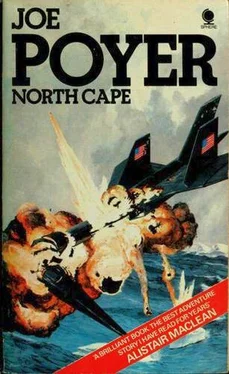He straightened the turn abruptly and pulled the nose up quickly. The ECM was in full operation again and, as he started into the climb, the A-17 released a ghost-image missile that, traveling at his speed, began to pull away from the aircraft into the same spiral course that he had been flying. The violent turn that the Falcon had made in an effort to catch him inside should have lost the A-17 to the visual observer. The ghost image, a small, ramjet-powered affair, was further complicating matters by producing the same signal that simulated the mother A-17. Teleman could see the pattern plainly on his own radar screen as it pulled farther and farther away. After the two were separated by several mile; the computer, following Teleman’s instructions, began to turn the ghost away from the spiraling descent into a straight run south, as if running from the Soviet aircraft.
Teleman hoped, hoped so hard it was almost a prayer, that there was a terrific argument going on between the pilot and observer on board the Falcon. If this bird was going to hold true to pattern, he had about another five minutes or so to go before he would have to drop out and turn the chase over to the next in line. Teleman wondered at the organization they must have to be able to figure out what he was up to: return the Falcons from their rotating picket duty nearly fifteen hundred miles northeast, land and refuel them, and put them back into the air less than two hours later, strung out in a perfect line to intercept him as he came sneaking across the border. Then he stopped cold. Or else they had one hell of a lot more of-these specially rebuilt Falcons than he had counted on. So far, he had faced four, and that meant they must be supported by at least twelve more if the pickets were to be effective. Since they would not know for sure where he would try to cross, the Soviets would have to keep at least thirty-six modified Falcons on the ready line. One set of twelve on station, twelve on their way from the base to the line, and twelve on the ground being serviced and fueled. “Ye gods,” he muttered.
Now it was beginning to look as if his long shot was going to pay off. The following Falcon began to come around on a course halfway between Teleman and’ the ghost so that he could keep an eye on both until he decided which was the real intruder. He was being a little more cautious than Teleman had planned on. The gap between him and the ghost had widened to 160 miles and he instructed the computer to pour it on. Instantly, the ghost leaped ahead at close to Mach 5 and the range began to open. By now, the crew of the Falcon must be desperate. He checked his altitude and leveled off at 180,000 feet to watch for further developments.
As he waited, a fourth Falcon appeared on the scope, screaming for altitude. The third began to drop back and finally, after a few seconds, turned sharply into a bank and began spiraling down. Overshot his fuel, Teleman thought grimly. He hoped their escape capsule was in good operating condition. The fourth Falcon moved up fast, but still was far below the altitude at which the third had fallen out. This was exactly the situation Teleman had been hoping for. He ran for the ice layer. The crystalline structure of the high altitude cloud was so tenuous as to be almost nonexistent, in fact it was detectable only by instruments, but still thick enough to reflect radar waves. He did not have to worry about radar sighting, but the thin haze the cloud.cast would also make optical tracking that much more difficult in the strong, late morning sunlight. Seconds later he began the second phase of his plan by falling off slowly southward.
It was rare to see an ice cloud layer of this extent much above ninety thousand feet; although scattered and shredded bits of ice could always be found at this altitude. The effects of the Arctic storm, Teleman thought, even 3600 miles south. Anyway, it was here and he was going to make darned good use of it. Safely into the nebulous ice layer, he, settled back to the long chase that would lead him north and west across the Asian landmass.
His radar screens indicated that the Falcon was still tracking the ghost by radar. The readout indicated that they would close.up enough within four minutes to spot it as a phony on the visual apparatus. And when that happened, all hell was going to break loose. And sure enough, after four long minutes, in which Teleman widened the gap between the A-17 and the pursuing Falcon by nearly five hundred miles, he spotted the Soviet craft coming around in a tight half turn. Obviously they had discovered the ghost for what it was and were now running back to the projected path of the last visual sighting. When they got there, they would find him nowhere in sight — he hoped. Sure enough, here came the reinforcements. Four more Falcons were rising fast along the path where they had last sighted him. As unobtrusively as possible, he fell off.even farther south. Now that the Reds were lost in the dust, he was free for the moment to cope with other problems. Right now he was safely out of range of the visual gear. In fact, by dropping off south, he was now falling behind the fourth and rearmost Falcon. He was pretty sure the Soviets would figure that he would pull a trick like this and would right now be using all of the radar at their disposal to try and spot the blind area, now less than a mile wide, that his ECM gear was causing. That would explain the systematic spacing of the four Falcons, each two hundred miles apart. In addition, they might shortly be using their mid-continental radar line, jacked around south to search for him. It was time to increase the ECM before they did pick him up.
As Teleman reached for the ECM gear panel, he caught a flicker of light on the radar screen as one of the Falcons changed course.
The digital readout chattered quickly. Too late, he groaned inwardly. Either one of the aircraft or the ground stations had picked him up. The Falcon was heading directly for him. Working quickly, he extended the counterdetection range to its full sixteen-hundred-mile range. It seemed to have no effect on the approaching Falcon. He could not spot a single indication of wavering or uncertainty. Swearing softly, Teleman checked the fuel-load readouts. Mach +5 was the limit unless he wanted to crash somewhere in Poland or France, out of fuel. The contact-point readout.now gave him six minutes before the Falcon reached missile range. He checked his location quickly and found that he was south of the ancient capital of the Mongolian Khan Timur-i-leng, the city of Samarkand, less than three hundred miles from the Afghan border. Would the Soviets hesitate to cross the border, as they had north over Sinkiang? There was only one way to find out, he thought grimly, and dropped into a steep turn south, sliding down in a long glide that would bring him across the border at 140,000 feet. It was a desperate gamble, but one that had to be taken.
The next six minutes passed slowly. Teleman fled south for the border pursued by the Falcons, slowly gaining ground by their relay tactics. As the chase lengthened, Teleman began to observe the flight characteristics of the other pursuing aircraft. His radar showed two other bandits wheeling into the flight line from the north. He could imagine them strung out in a long line, in both directions, all the way to the air base at Alma Alta. Of the two on his radar beside the immediate pursuer, one was heading back. The sudden flurry of activity involving the four Falcons when they thought they had lost him obviously had not exhausted them. Then on the horizon Teleman spotted the Amu Dar Ya, the river that formed the northeastern border, separating the Soviet Union from Afghanistan.
The radar screen showed the second following Falcon almost within range, and indicated that Teleman would cross the border with seconds to spare. As if realizing that he was losing his prey, the Soviet pilot fired a salvo of missiles. Teleman watched the two rockets spurt ahead of the aircraft and begin to close in on him with deadly silence. As soon as the missiles were away, the Falcon throttled back and dropped swiftly down in a sharp turn, trying desperately to conserve fuel for the impossible run back to the Alma Alta base eight hundred miles north.
Читать дальше












